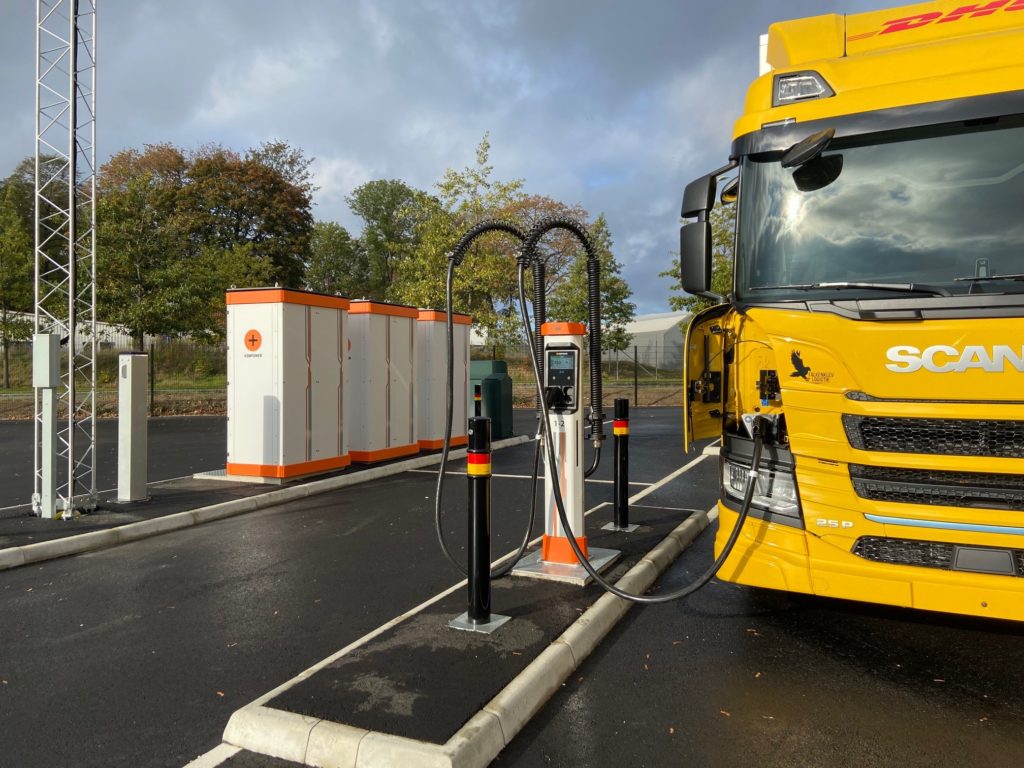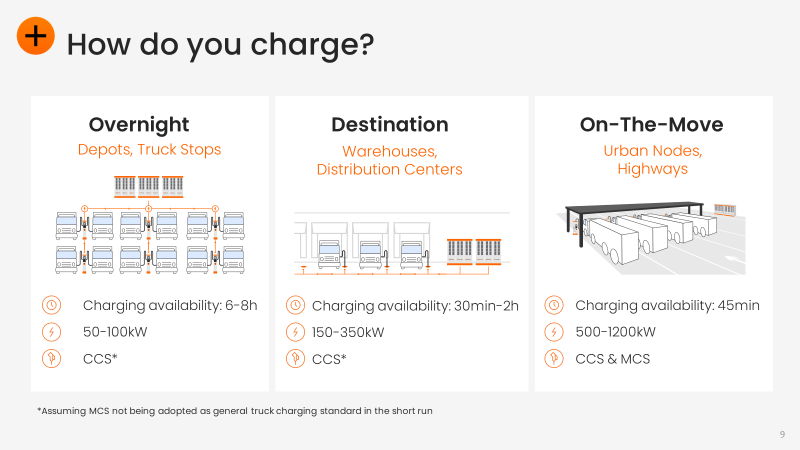Switching to Electric: What to Know about Electric Truck Charging
Electric trucks are gaining traction as a sustainable alternative to traditional diesel trucks. Traditional heavy-duty trucks account for more than 25% of the total CO2 emissions from road transport. So, it’s clear that transitioning truck fleets to electric would have a major impact on climate change mitigation. An electric fleet also helps businesses get ahead of the competition by meeting sustainability demands.
But, what’s slowing down the widespread adoption of electric heavy-duty trucks?
Range.
The limited range of e-trucks has caused some businesses to hesitate on electrifying their fleets. Even though for most inner-city trips, e-trucks have sufficient range to complete their routes. However, we can overcome the general hesitations that come with switching to electric by leaning on reliable electric truck charging infrastructure. Convenient electric truck charging stations will be a major key to enable heavy-duty transport.
In this article, we’ll dive into how to charge electric trucks. We’ll look at different electric truck charging scenarios, the stages of electrification for trucks, and the advantages of transitioning to electric trucks.
What are examples of an electric truck?
The term electric truck is broad and encompasses a variety of battery-powered truck models. But for this article, we’ll turn our attention to medium- to heavy-duty electric trucks used for:
- inner city local trips (medium-duty trucks)
- regional, mid-haul trips (medium- to heavy-duty trucks)
- long-haul trips (heavy-duty trucks)

Image from Falkenklev Logistiks electric truck charging station in Sweden
How does electric truck charging work?
Charging an electric truck is typically done with a DC fast charger. This charger is connected to either the electric grid or an alternative power source. The most efficient method for charging electric trucks depends on several factors. Some of these factors include travel distance and battery size.
To differentiate between charging methods for heavy-duty electric trucks, let’s discuss both different charging scenarios and truck electrification stages.
What are the electric truck charging scenarios?
When it comes to powering heavy-duty electric trucks, the charging strategies typically vary between overnight charging, destination charging, and on-the-move charging. How long it takes to charge an electric truck also depends on these different charging scenarios:
- Overnight charging is the most common charging scenario. Fleet owners can charge their fleets overnight with low DC powers of 50-100 kW. This works well because there are normally 6-8 hours available during the night to fully charge the vehicles. Truck charging management software, like Kempower ChargEye, can help save energy costs through functionalities like peak shaving and load balancing.
- Destination charging is necessary for vehicles which range is smaller than their daily distance driven. Destination charging can take place at logistic centers or warehouses. During these charging sessions, between 150 and 400 kW of power are used to recharge e-trucks in 30 minutes to 2 hours during loading and unloading.
- On-the-move charging will be needed along urban nodes and highways for long-haul truck trips that cover large distances per day. To efficiently utilize the mandatory driver breaks of 30-45 minutes regulated by the EU, higher powers of up to 1.2 MW will be needed to recharge the vehicles in time.
In summary, electric trucks are typically charged with a DC fast charger either overnight, at a warehouse destination, or on-the-move along highways. It can take anywhere from 30 minutes to 8 hours to charge an electric truck depending on the charging scenario.

Image by Kempower
Truck electrification stages
We’ve found that the adoption of electric trucks and the charging infrastructure can be viewed in stages. These stages represent the current state, the near future, and the future of the electrification of trucks.
The first stage where electrification is currently happening the fastest is for local and regional trips.
In this phase, you can see the electrification of mostly rigid trucks. It’s common for heavy-duty trucks in this phase to use private overnight charging at truck depots with 50-100 kW of power. This is because the range of trucks in stage one is usually sufficient to cover their daily distance. Destination charging is slowly evolving as some truck trips need recharging at logistic centers to cover their distances.
The second stage of truck electrification is that of regional and mid-haul trips. In this stage, more articulated trucks are electrified. There is an increased demand for destination charging at logistic centers and integration of charge management in the logistic processes. Many fleets in this stage will also benefit from government subsidies. Public charging is becoming increasingly popular with high power charging stations at urban nodes. These stations offer megawatt charging systems of over 500 kW.
The third stage, long-haul trips, would be the final step of complete truck electrification. In this phase, there would be automated and fully integrated charging processes at distribution centers. Additionally, large-scale government subsidies and megawatt charging opportunities along highways make this stage feasible. Public overnight-charging options at rest areas will also support this stage.
The benefits of electric trucks
Global initiatives, like EU regulations and directives, are driving forward the electrification of heavy-duty trucks. These initiatives call for clean mobility solutions. Electric trucks emit zero tailpipe emissions. This makes them a more sustainable option for businesses needing to reduce their carbon footprint.
The initial investment of an electric truck is higher than that of an ICE truck. However, the numerous benefits of electric trucks will drive towards total cost ownership (TCO) parity in this decade. In some countries electric trucks have already achieved TCO parity with ICE trucks.
Just a few of the benefits that help drive down total cost ownership for electric trucks are:
- Reduced fuel costs
- Maintenance savings
- Government incentives
- Road toll exemptions

Image from WattHub
The future of electric trucks and electric truck charging
Electrification is the direction heavy-duty transport is driving towards. This is good news for both the environment and truck businesses in the long run.
However, the cause-and-effect dilemma is at play for the electric truck industry. What do we need to focus on first, the charging solutions or the electric trucks? Without appropriate charging infrastructure in place, it’s hard to get more heavy-duty trucks on the road. Without more electric trucks coming to the market, it’s hard to rally behind better charging infrastructure.
To accelerate the electrification of heavy-duty transport, we believe it starts with building accessible and extensive charging networks. When charging infrastructure is reliable and it covers enough areas, end customers are more ready to buy electric trucks. Fleet owners need to be confident that they can use electric trucks without any difficulties.
Check out how Kempower’s fast charging solutions are helping power electric truck charging stations in Australia and the largest truck charging station in Sweden.
Written by
Jade Ventoniemi & Moritz Vornfeld
Marketing Specialist – Segment Owner Fleets
